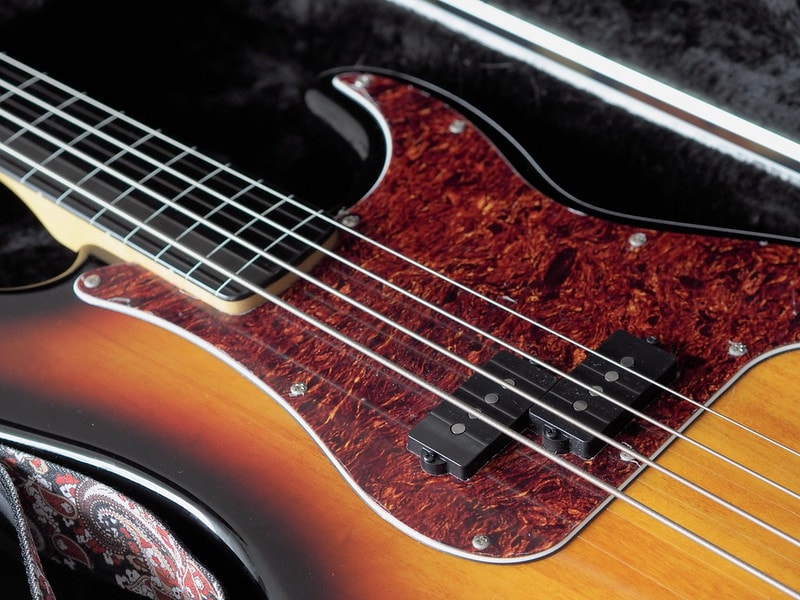
How Long Does It Take To Get Good at Guitar?
September 8, 2022
How To Sing Better Without Lessons
October 15, 2022
The guitar is one of the most versatile instruments out there. Musicians can use it to play mind-bending solos, from classic rock stars like Eddie Van Halen or romantic Ed Sheeran wedding songs.
These instruments can produce an extensive range of sounds, complementing various genres and timbres. Read on to learn more about some of the different types of guitars.
The Different Types of Guitars
Acoustic Guitar
People have used stringed instruments since ancient times, but history credits German-born American Christian Frederick Martin as the inventor of the first steel-string acoustic guitar in 1843. His design’s unique X-bracing system provided the guitar with greater volume and projection.
Today, the acoustic guitar is the most popular and widely used guitar type globally. It’s the instrument most of us imagine if anyone mentions the word guitar. While manufacturers offer various shapes, including dreadnought, double-O, and grand auditorium, all of them use steel strings and tonewoods.
Musicians play these instruments similarly. Once they pluck any of the strings, the vibration moves around and resonates through the air inside the body to produce a sound.
Guitar producers often use tonewoods such as ebony, mahogany, and spruce to build them. While every material creates a distinct sound, many consumers love acoustic guitars because of their precise tones, especially in higher frequencies.
We recommend acoustic guitars for various types of music, including country, folk, pop, and slow rock tunes.
Electric Guitar

There would be no electric guitar without its acoustic counterpart. In 1936, jazz guitarist Charlie Christian started playing his acoustic guitar with a pickup attached to the body to enhance his guitar solos. Many chroniclers believe his style inspired the electric guitar we enjoy today.
Initially, brands designed electric guitars for jazz players to play loud enough in a band of brass instruments. Later on, enthusiasts started applying amplification strategies to address this concern.
Here’s how modern electric guitars work: the pickups convert the string vibrations into electrical signals sent to an amplifier. The amplifier then converts the signal into sound and magnifies it.
Like acoustic guitars, modern electric guitars have a bridge, body, and neck. However, the former guitar type uses a hollow design, and the former has a solid body. Also, electric guitars are easier to play because they are smaller and have lighter, more comfortable strings.
Electric guitars have produced some of the most notable classics, from Deep Purple’s Smoke on the Water or Eric Clapton’s Layla to Nirvana’s Smells Like Teen Spirit. Whether you’re into creating rock, country, pop, blues, or jazz music, you can add an electric guitar element to your sound to amp it up.
Bass Guitar

During the 1920s, inventor George Beauchamp started looking for a guitar with a deeper and louder sound than typical string instruments. Because of this need, he created versions of the bass guitar later improved by other enthusiasts. This invention paved the way for other similar contraptions.
Fast forward to the 1930s, another inventor Paul Tutmarc developed a horizontally-played double bass reminiscent of the bass guitars we see today. Over the years, various prototypes and models emerged in the market.
Inventor and manufacturer Leo Fender invented the first electric bass guitar during the 1950s. This prototype became the first widely used and commercialized version. Twentieth-century musicians, like James Jamerson and Bootsy Collins, popularized this guitar type by exploring the newfound possibilities of deep frequencies.
Bass guitars resemble their electric equivalent, but have a lower sound frequency. They produce notes about an octave lower than the acoustic guitar. For this reason, you’ll usually spot them offering supporting sounds to bands.
You can use bass guitars to play bass lines — the lowest note sequence in music — to complement various genres such as punk rock, reggae, or even gospel.
Classical Guitar
Historians agree that two older instruments inspired the classical guitar: the vihuela and the Baroque guitar. The vihuela is a 15th-century string instrument linked to Spain, Portugal, and Italy. While it looked like a modern guitar, it sounded more like a lute.
The Baroque guitar, on the other hand, is a 17th-century design with five courses of gut strings. It became a well-loved solo and accompaniment instrument in several European countries.
The classical guitar we know now hails from the Renaissance. This instrument used four pairs of strings, later replaced by the five-course guitar. During this time, musicians started the A, D, G, B, E tuning we use now for the top five strings. This era also paved the way for more frets, increasing them from eight to twelve.
A few years later, the guitar evolved into a six-string instrument, replacing the course-string design. In 1862, Antonio de Torres Jurado created the first modern classical guitar. While his guitars were smaller than those we see today, his design became the industry standard.
Today, manufacturers use wood and nylon strings for classical or Spanish guitars instead of metal ones. They also create 12 frets, with the last fret joining the neck to the guitar’s body. These features differentiate them from their acoustic and electric counterparts.
Andres Segovia — a Spanish virtuoso classical guitarist — introduced the instrument to a global audience. His musical genius proved that the classical guitar was a capable concert instrument powerful enough to grace massive venues.
To this day, Andres Segovia is still one of the most notable guitarists in history. He boasts an impressive student list that includes John Williams, Christopher Parkening, and Oscar Ghiglia. His legacy continues to inspire classical musicians, bossa-nova artists, and guitar novices alike.
Twelve-String Guitar
Twelve-string guitars are some of music’s biggest mysteries. These instruments arrived in the U.S. at the start of the 19th century, but no one knows where they originated.
Archivists guessed that they either came from Italian or Mexican immigrants. Residents of ancient Italy boast a rich history of double-stringed instruments, like the lute and mandolin. The Italian luthiers in U.S. guitar factories could have played around with the standard six-string guitar. After all, many known makers of the 12-string guitar today have a strong Italian connection.
They also could have hailed from Mexico, where music lovers enjoyed adding extra strings to the standard guitar, like the guitarra séptima and bajo sexto. The Mexican settlers of that time may have brought their instruments to the country.
While no one can prove who invented the 12-string guitar, it was a popular choice for street performers of the time. Manufacturers built and sold them cheaply, making them a perfect option for the masses.
However, as time passed, the 12-string guitar made waves with folk musicians. Later, rock artists like Jimi Hendrix, Stevie Ray Vaughan, and Tom Petty incorporated this instrument into their work.
While it’s more challenging to learn than a 6-string guitar, you can use 12-string instruments to add depth and sparkle to your strumming patterns.
Resonator Guitar

You’ll know right away when you see a resonator guitar — in our opinion, it’s one of the coolest instruments ever made. They either boast glossy metal bodies or wooden cases with massive cones. These guitars look as loud as they sound, making them stand out in a crowd.
Since the conception of the acoustic guitar, inventors have tried different techniques to amplify its sound. For instance, in the mid-1920s, entrepreneur John Dopyera created the first resonator guitar to compete with big bands of his time. He teamed up with fellow inventor George Beauchamp to form the National String Instrument Corporation, the company behind the instrument’s first release.
The first resonator guitar available in the market was a metal-bodied device with three conical aluminum sound chambers.
However, because of conflicting design and business philosophies, the Dopyera Brothers overtook the National String Instrument Corporation to form the National-Dobro Corporation. Today, many people still use the term Dobro for resonators. The name is fitting, since most manufacturers still use the same template the brothers did.
Before electric guitars became popular, musicians preferred resonator guitars for larger venues and louder bands. Today, artists still use them for bluegrass music and blues.
Archtop Guitar

Like the mandolin, the archtop guitar is a distinctly American version of a traditional European musical instrument. You can tell archtop instruments apart from other types of guitars because of their carved, arched soundboard and back, like a violin.
Chroniclers credit luthier Orville Gibson as the inventor of the archtop guitar. In 1896, he applied for a patent for a mandolin-like instrument with a carved top and back. His application explains that the goal of the archtop guitar is to enhance the mandolin’s sensitive resonance and vibratory action to produce a more powerful sound with higher tone quality. Governing authorities awarded Gibson the patent on February 1, 1898.
Today, musicians and ensemble players use the archtop guitar for its improved projection and distinct punchiness. Notable fans include Barney Kessel, Johnny Smith, and Tal Farrow.
We recommend these instruments for those who want to play jazz, blues, and rockabilly music.
Multi-Neck Guitar

As the name implies, multi-neck guitars come with at least two neck fretboards. The most common type is the double-necked guitar, which can be acoustic or electric. These instruments may observe various combinations, but you’ll often find 6- and 12-string necks in the market.
Like twelve-string guitars, historians cannot credit the creation of the multi-neck guitar to one person. They might have been around since the inception of the guitar.
One of the earliest examples of this instrument dates back to 1690, built like the famous Alexandre Voboam — a small, almost ukulele-sized guitar. During those times, professional musicians used it with an ensemble or orchestra.
However, experts agree that these instruments are likely a curiosity and not the norm. After all, musicians often feel that they have enough on their hands when working one set of strings.
However, once you learn the workings of the multi-neck guitar, you will appreciate its benefits. For instance, you can play a song requiring a 6-string and a 12-string guitar without swapping instruments halfway through; it’s like harnessing the power of two devices at once.
John McLaughlin, Rick Nielsen, and Steve Vai are some of the most popular fans of the multi-neck guitar. And remember, you don’t have to limit yourself to two necks!
Harp Guitar

The harp guitar is a guitar-based instrument with extra features that can accommodate individual plucking. The word harp refers to its unstopped open strings. While playing the harp guitar requires more skill and technique, they also offer additional musical flexibility.
In 1773, harp maker Naderman created the first harp guitar in Paris. The instrument featured six standard fretted strings and six open bass strings, each with a thumb lever to raise the pitch. Naderman dubbed his creation Bisex, which means double-six.
In 1890, luthier Chris Nutsen created a hollow arm to extend the upper part of the harp guitar, improving its look and tone. This enhancement paved the way for the instrument’s popularity throughout the U.S. His design still resembles the ones we use today.
Some of the most notable guitarists using harp guitars include Michael Hedges, Tim Donahue, and William Eaton. If you want to boost the range and resonance in your music, this instrument is perfect for you.


